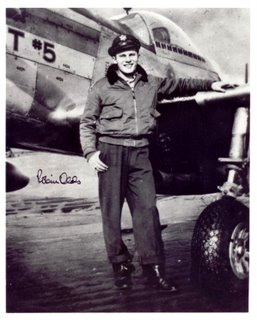Robin Olds 1922-2007

Robin Olds was born into an Army family and grew up hearing stories about Brig. Gen. Billy Mitchell from his father, who was a major general in the Army Air Corps and, at one time, Mitchell's aide. With such a unique childhood, it's perhaps no surprise that Olds became an American triple ace and a strong advocate for tactical air power.
Olds was born in Honolulu, Hawaii in July 1922 and spent his boyhood in the Hampton, Va., area where he attended elementary and high school. He graduated from the U.S. Military Academy at West Point, N.Y., and was commissioned as a second lieutenant in June 1943. In 1942, while playing for the academy football team, Olds was selected as an All-American tackle.He completed pilot training in 1943. Joining the 479th Fighter Group, he sailed to England in May 1944. By summer, he was a captain in the 434th Fighter Squadron, flying a P-38J Lightning named "Scat 1." He became an ace in his first two combat missions, shooting down two FW-190s on Aug. 14 and three Me-109s nine days later.The 479th re-equipped with P-51 Mustangs in September and Olds scored his first kill in "Scat V" on Oct. 6. Promoted to major in February 1945, he claimed his seventh victory southeast of Magdeburg, Germany the same day. On Feb. 14, he recorded three confirmed victories in one day, two Me-109s and an FW-190. By the end of his tour, he had shot down 13 German planes, destroyed 11.5 others on the ground, and was commander of the 434th.
Back stateside after the war, Olds was the wing man on the first jet acrobatic team in the Air Force. He also participated in the first one-day dawn-to-dusk, transcontinental roundtrip flight in June 1946 from March Field, Calif., to Washington, D.C., and return.In October 1948 he went to England under the U.S. Air Force – Royal Air Force Exchange Program and served as commander of No. 1 Fighter Squadron at Royal Air Force Station Tangmere, and missed Korean War action. From 1955 to 1965 he commanded two wings in Europe and in September 1966 took over the 8th Tactical Fighter Wing at Ubon, Thailand.
Now a 44-year-old colonel, Olds took to the air war over North Vietnam in an F-4C Phantom named, "Scat XXVII." During "Operation Bolo," a fighter sweep against MiG-21s in January 1967, he shot down one MiG and added another over Phuc Yen Airfield in May. Operation Bolo was a program in which the electronic countermeasure pods of F-4s were replaced with F-105 pods. The resulting false signal enticed MiGs to engage the F-4s-- thinking they were engaging the slower, less agile F-105.Two weeks later, he destroyed two more MiGs, bringing his total to 17 confirmed kills (13 in World War II and four in Vietnam), making him a triple ace. He flew 107 combat missions in World War II and 152 combat missions in the Vietnam War. "Scat XXVII" is at the Air Force Museum, Wright-Patterson Air Force Base, Ohio.Olds was promoted to brigadier general in May 1968. He became director of aerospace safety in the Air Force Inspection and Safety Center at Norton AFB, Calif., in February 1971 and retired in June 1973.
Olds was known for the extravagantly waxed, handlebar mustache he wore in Vietnam. It was a mark of his individuality. Returning home, however, he discovered not everyone was fond of his maverick behavior. When he reported to his first interview with Air Force Chief of Staff Gen. John P. McConnell, he stood at attention and rendered a sharp salute. McConnell walked up to him, stuck a finger under his nose and said, "Take it off." Olds said, "Yes, sir."Although know for his flamboyance, Olds was a strong advocate of the importance of tactical air power, just as his father was years before. They both considered the ability to do one job in one mission with surgical precision the ultimate doctrine of air power.


<< Home